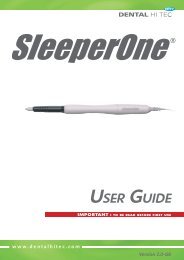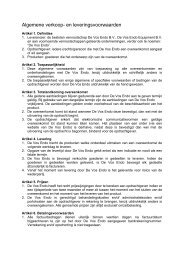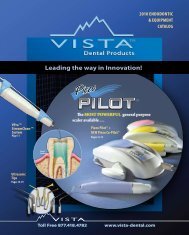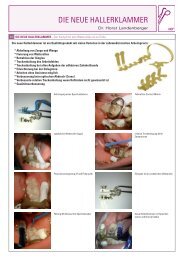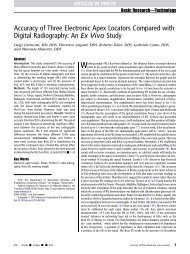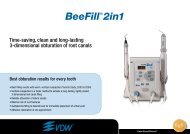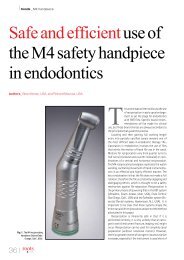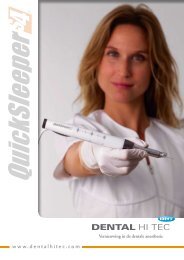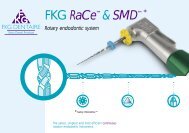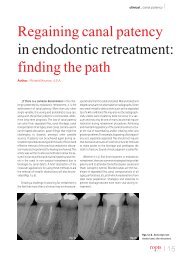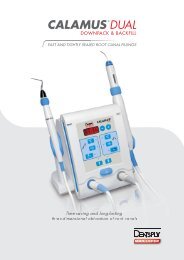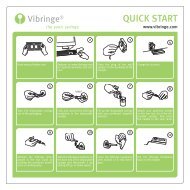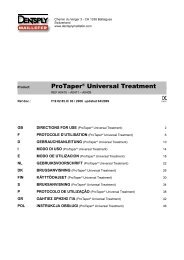Current Philosophies - De Vos Endo BV
Current Philosophies - De Vos Endo BV
Current Philosophies - De Vos Endo BV
- No tags were found...
You also want an ePaper? Increase the reach of your titles
YUMPU automatically turns print PDFs into web optimized ePapers that Google loves.
Earn4 CE creditsThis course waswritten for dentists,dental hygienists,and assistants.<strong>Current</strong> <strong>Philosophies</strong>4527in Root CanalObturationA Peer-Reviewed PublicationWritten by Richard E. Mounce, DDSPennWell is an ADA CERP recognized providerADA CERP is a service of the American <strong>De</strong>ntal Association to assist dental professionals in identifyingquality providers of continuing dental education. ADA CERP does not approve or endorse individualcourses or instructors, nor PennWell does it imply is an acceptance ADA CERP of credit Recognized hours by boards Provider of dentistry.Concerns of complaints about a CE provider may be directed to the provider or to ADA CERP atwww.ada.org/goto/cerp.Go Green, Go Online to take your courseThis course has been made possible through an unrestricted educational grant. The cost of this CE course is $59.00 for 4 CE credits.Cancellation/Refund Policy: Any participant who is not 100% satisfied with this course can request a full refund by contacting PennWell in writing.
Educational ObjectivesThis article will review the principles of root canal obturationand obturating materials currently available.Upon completion of this course, the dental professionalwill be able to:1. Know the main factors influencing endodontic success2. Know the advantages and concerns around the use ofgutta percha3. Know the options available for root canal obturation andhow these differ4. Know the characteristics of recently introduced carrierbasedobturators and their clinical application.Abstract<strong>Endo</strong>dontic materials and techniques have advanced dramaticallyin the last two decades. Historically, gutta perchatogether with sealer has been the obturation of choice.Gutta percha is versatile, with a long history of use. However,it is not able to bond to obturating materials or to thetooth. Techniques for obturating root canals include theuse of heat or chemically-softened gutta percha, injectiontechniques, ultrasonics, vibration and carriers. Carrierbasedmaterials are available that utilize a core carrieraround which obturating material is coated. The introductionof bonded obturating materials (methacrylate resins)has enabled the clinician to obtain a bonded seal to the rootcanal dentin in areas reached by the etch/adhesive materials.In addition, a carrier-based system is now availablethat combines a carrier technique and adhesive technologyfor bonded obturation.IntroductionRoot canal treatment in the mid-1700s included the use ofpoultices, leeches, and pulpal cauterization. 1 Since that time,much has changed. During the last two decades alone, thescience and practice of endodontic therapy have advanceddramatically with the introduction of evidence-based andvalidated protocols as well as modern techniques and materials.These have paralleled advances in other disciplines. Theintroduction of surgical operating microscopes, the use ofrotary nickel titanium instruments and, within the last year,twisted nickel titanium instruments, research on irrigantsand smear layer removal, and the introduction of advancedbonded obturation and sealer materials and techniques haveall played a role and continue to do so. 2The final step in endodontic therapy is root canal obturationwith the objectives of attaining apical and coronal seals,sealing lateral and accessory canals, and consistently fillingall pathways from the root canal system to the surroundingperiodontal ligament. Prior to obturation, the canals mustbe adequately cleaned such that they are free of debris anddisinfected to remove microbes, and the shape of the preparedcanals must enable clinically acceptable obturation.Removing the smear layer with an appropriate product priorto obturation reduces subsequent microbial leakage throughthe root canals. 3It is important to note that the final restoration mustprovide excellent coronal seal; when a build-up is required itshould be performed using a rubber dam to prevent contamination,and the seal created by the obturation materials mustnot be disturbed.Hommez et al. reported that inadequate coronalrestorations resulted in a 49.1% incidence of apical periodontitisversus 23.8% for those teeth with an adequatecoronal restoration, underscoring the importance of thefinal restoration for clinical success. 4 Research has shownthat periradicular lesions are prevalent in teeth with poorcoronal restorations; and that the quality of obturation isthe most critical factor. 5 The success of endodontic therapyand the long-term viability of the tooth are compromisedif any step in the endodontic and restorative procedure isinadequate (Figure 1).Figure 1. Failed endodontic/restorative therapyObturating for Successful OutcomesRoot canal obturation must be complete, fill all main canalsto full length to provide an apical seal, and fill all accessorycanals. Obturation that is of inadequate length ornon-homogenous has been associated with a significantlyincreased presence of periapical disease assessed withinone year post treatment. 6 Until recently, lack of a coronalseal or disturbing the coronal seal during restoration havebeen problems for root canal therapy even where the obturationwas otherwise clinically acceptable.Gutta percha combined with use of a sealer was historicallythe standard for root canal obturation. The introductionof obturation materials that can be bonded to rootcanal dentin and the use of bonded materials for coronaldentin have enabled improved coronal seals that are lesssusceptible to being compromised during restoration.In addition, the introduction of new thermoplastic techniquesand carrier-based obturating materials provide theclinician with more options during obturation.2 www.ineedce.com
Gutta PerchaGutta percha offers a number of advantages and disadvantagesas a root canal obturating material. Advantagesinclude biocompatibility, ability to be heated and softenedfor canal placement, compatibility with sealer materials,and technique flexibility. It can be used with sealer coatedon it, after sealer is placed in the canal, using an injectiontechnique, used with a carrier, compacted, and placedwith vibration and ultrasonics, and it is flowable. Guttapercha is also relatively inexpensive and readily available,has a long history of use, and can usually be readilyremoved from root canals in cases requiring retreatment.Nonetheless, there are some concerns with gutta percha.Gutta percha does not provide a seal, irrespective of theplacement technique, and must always be used with asealer. Further, if the gutta percha has been heated priorto placement, it can shrink as it cools. Use of gutta perchahas been found to create the potential for significant voidsif a lateral condensation technique is used. 7 Voids wouldbe more likely to occur with use of an inadequate amountof sealer. Lastly, it bonds neither to the root canal dentinnor to the accompanying sealer, nor does it influence thecoronal seal (Table 1). Excellent coronal seal is a key factorin endodontic success, and is not influenced by the presenceor absence of gutta percha. 8-13and, more recently, methacrylate resin sealers. Sealers fillvoids between gutta percha points when multiple pointsare used, and are responsible for obtaining apical andcoronal seals and the sealing of accessory canals to preventmicroleakage and recontamination. Therefore, they are allfactors in endodontic success. 14Resin sealers based on adhesive technology bond to rootcanal dentin when appropriately used. Ideally, if a resin-basedsealer is used it should also be able to bond to the selected rootcanal obturating material. If the obturating material is guttapercha, such bonding cannot occur.Resin-Bonded Obturating Materials and SealersAH Plus is an epoxy-based resin sealer. Resin-bonded obturatingand sealer materials include <strong>Endo</strong>REZ ® and RealSeal (also distributed as Resilon ® /Epiphany ® ) (Figures 2, 3, and4). These are methacrylates. Neither epoxy resin nor methacrylateresin sealers can be bonded to gutta percha.Figure 2. <strong>Endo</strong>REZ®Table 1. Advantages and disadvantages of gutta perchaAdvantagesLong history of useBiocompatibilityFlexibility of techniqueThermoplasticCompatibility with sealersEasily removedInexpensiveDisadvantagesProvides no sealInability to bond to dentinInability to bond to sealersShrinks upon coolingPotential for voidsMust be used with a sealerFigure 3. Resilon®/Epiphany®Compounds that have been used as sealers in conjunctionwith gutta percha include calcium hydroxide, calciumphosphate, zinc oxide eugenol, AH Plus (epoxy resin),www.ineedce.com 3
Figure 4. RealSealFigure 5. <strong>De</strong>ntinal tubulesCourtesy of Dr. Jeeraphat JantaratFigure 6. Monoblock layerBoth RealSeal and <strong>Endo</strong>REZ ® are hydrophilic andare used in the presence of a slightly moist root canal environment.<strong>Endo</strong>REZ ® consists of urethane dimethacrylatewith zinc oxide, barium sulfate, resins, and pigments. It is atwo-component sealer that is used in conjunction with guttapercha points. <strong>Endo</strong>REZ ® can be placed in the root canal,followed by gutta percha points or resin-coated gutta perchapoints. <strong>Endo</strong>REZ ® has been found to result in deep dentintags when bonded to slightly moist root canal dentin and tohave good clinical success when the manufacturer’s instructionsare followed. 15RealSeal and sealer have been licensed from Resilon® and are identical to Resilon ® obturating points andEpiphany ® sealer. RealSeal obturating points and theself-etch sealer are used as a system and require priorremoval of the smear layer. Optionally, primer can beused as well. The primer consists of an acidic monomerin water, and the RealSeal points are composed ofpolyester polymers, methacrylate resin, bioactive glass,and radiopaque fillers. The sealer consists of BisGMA,UDMA, EBPADMA, PEGDMA, silane-treatedbarium borosilicate glasses, peroxide, amines, pigment,stabilizers, barium sulfate, silica, bismuth oxychloride,calcium hydroxide, and photo initiator.By removing the smear layer with EDTA as the finalstep in canal preparation, the dentinal tubules are exposedto the primer (Figure 5). Once the self-etch primer has beenapplied, a monoblock layer is created when the RealSeal isinserted (Figure 6). This results in a bonded obturation witha contiguous structure from within the dentinal tubules tothe core of the obturating material, with true sealing off ofthe canal possible where the primer and RealSeal contactthe desmeared dentin of the canal wall. RealSeal is highlyopaque and nontoxic.RealSeal can be handled almost identically to guttapercha. It can be used with a lateral or vertical condensationtechnique, can be compacted, and can be used in an Obturagun (Spartan Obtura, Fenton, MO) and injected into thecanal instead of used as points. An Elements ObturationUnit (Sybron<strong>Endo</strong>, Orange, CA) can be used to heat thematerial and place it, using disposable cartridges and theSystemB obturating technique.Figure 7. Elements Obturation Unit4 www.ineedce.com
Since handling Resilon ® is essentially the same as handlinggutta percha, this removes the need to learn a new technique.RealSeal (Resilon ® ) has been found in a number of studiesto reduce microleakage in comparison to gutta percha andseveral different sealers, including AH Plus. 16-19 Based on theauthor’s clinical experience as well as evidence in the literature,use of RealSeal offers good clinical success rates. 20In addition to improved sealing ability and the potentialfor reduced microleakage, resin sealers may offer thepotential for increased resistance to root fracture. Thereare conflicting reports in the literature. Texeira et al. foundthat RealSeal (Resilon ® ) offers superior resistance to rootfracture compared to gutta percha using a vertical or lateralcondensation technique. 21 A second study found that bothRealSeal (Resilon ® ) and <strong>Endo</strong>REZ ® increased resistance tovertical fracture. 22 Other studies, however, have found noimprovement or reduced fracture resistance compared tomore traditional obturating materials. 23-25Carrier-Based ObturationCarrier-based obturation materials provide a vehicle fordelivery of the root canal filling material in one step. Thesematerials are either delivered cold or thermosoftened. Ithas been claimed that using a carrier-based system is easierthan using other obturation techniques, although this maybe due to individual variations, experience, and preferences.Irrespective of the method of obturation, appropriatecleaning and shaping of the root canal(s) will determineboth the success and ease of obturation for a given canal.Products that fall under the carrier-based category include<strong>De</strong>nsfil (<strong>De</strong>ntsply, Maillefer N.A., Tulsa, OK), Pro-System GT ® Obturators (<strong>De</strong>ntsply, Tulsa <strong>De</strong>ntal, Tulsa,OK), Soft-Core ® (Soft-Core ® Texas, Inc., North RichlandHills, TX), Successfil (Hygienic-Coltene-Whaledent, Inc.,Akron, OH), and Simplifill (Discus <strong>De</strong>ntal, Culver City,CA). All these carrier-based systems utilize gutta perchaand, with the exception of Simplifill, involve thermosofteningof the gutta percha with the carrier remaining in the canalas an integral part of the obturating material. SimpliFillis a cold carrier and involves removing the carrier after it hasbeen used as a delivery vehicle for the obturation material.Simplifil is used after preparing the canal(s) with LightSpeedinstruments (Discus <strong>De</strong>ntal) and matching the carrier to thefile used to working length. Only the apical portion of thecarrier has a coating of gutta percha or Resilon ® . This techniquecan be used with a conventional sealer or a resin-basedsealer such as RealSeal or <strong>Endo</strong>REZ ® . Stein et al. foundthat a technique using a Simplifill/gutta percha master coneresulted in no apical dye leakage in in vitro testing. 26ThermafilThe original Thermafil ® was introduced in the United Statesas a metal carrier coated with gutta percha. ContemporaryThermafil ® is available under the name Thermafil ® Plus andhas a flexible plastic carrier. Thermafil ® Plus is available ina variety of tapers, lengths, and tip sizes. Both the old metaland new plastic carrier systems have been found to be biocompatible,and equivalent in microleakage testing. 27-30Thermafil ® (Figure 8) is used by first ascertaining the requiredlength of the carrier for the canal, using the mm markersto set it to this length. The carrier is then heated in the heaterand placed into the canal. Insertion of the carrier should takeless than 10 seconds to optimize obturation and avoid reducedfill of the canal. Levitan et al. found that a rate of insertion of18 mm/second resulted in overextension (extrusion) of thefill, while underfill resulted from a rate of insertion of 3 mm/second. In general, the length of fill decreased with decreasingspeed of insertion. 31 Insertion without twisting is importantto avoid removal of the thermoplasticized gutta percha fromthe core. 32 One potential disadvantage is denudation of thecore with stripping and removal of the gutta percha coating. 33This would result in voids and inadequate filling of the rootcanal that may not be visible on a radiograph.Figure 8. Thermafil® carrierA number of studies have found Thermafil ® superior toa lateral condensation technique, while other studies havefound the lateral condensation technique superior. 34 Twostudies compared speed of obturation and found Thermafil ®to be the quicker of the two techniques, while a third found nodifference in the time taken. 35-37 Similarly conflicting resultshave been found across studies comparing Thermafil ® towarm thermoplastic obturation techniques. Apical extrusionof Thermafil ® during obturation is found with its use. 38 Aswith other carrier-based systems, care must be taken to avoidextrusion. The increased in temperature at the root surfaceusing Thermafil for obturation has been found to be upto 4.87 °C, depending on the root surface measured, and ithas been concluded that use of Thermafil would not result indamage to the periodontium. 39 Bonding adhesive resin technologycannot be used to adhere to Thermafil ® .SuccessfilSuccessfil utilizes a syringe system, with the pre-measuredcarrier length inserted into the syringe prior to extrusion ofwww.ineedce.com 5
the gutta percha onto the carrier and subsequent insertioninto the canal and completion of obturation. This techniqueoffers flexibility with respect to the shape and amount of guttapercha extruded onto the carrier.<strong>Endo</strong>dontic Retreatment<strong>Endo</strong>dontic (non-surgical) retreatment is necessary if apicalperiodontitis recurs. If obturation involved the use of retainedcarriers, the carrier must be removed together with the sealerand gutta percha coating. For Thermafil ® , this can be achievedusing heat or a solvent to soften the gutta percha, then a rotarynickel titanium file. If Thermafil ® Plus was used, solvent canbe used for the plastic core instead of a rotary file, providedthe carrier was at a minimum size 45. With smaller-diameterThermafil ® (sizes 40 and below), the carriers are mechanicallyremoved. An in vitro study assessing mechanical removal ofsize 30 Thermafil carriers from mandibular molar root canalsfound that removal took 1 minute and 28 seconds using size25 tapered files at 1500 rpm. 40 Whether or not a carrier-basedtechnique is used, gutta percha and sealer must be completelyremoved and the canals recleaned and reshaped during nonsurgicalretreatment. Standard gutta percha can be removedusing heat, solvents, or files, or a combination of these.Carrier-Based Resin-Bonded Obturation:RealSeal OneUntil recently, no carrier-based system existed that wouldenable the use of bonding adhesive technology. With the introductionof RealSeal One Bonded Obturators (RSOne), acarrier-based bonded obturating material is available (Figure9). RSOne contains a radiopaque core of polysulfone coatedwith RealSeal . Since the RSOne is one injection-moldedunit, the core is always centered in the obturating point. Thisenables placement with the core centered and an even layerof RealSeal available around it to bond to the sealer- as withother techniques, care must still be taken to place the carriercentrally in the canal. Only methacrylate sealer can be used– all other sealers are contraindicated. RSOne should be usedwith RealSeal SE self-etch dual cure resin sealer.Figure 9. RealSeal OneThe final prepared canal should be tapered appropriatelyfrom the orifice to the minor constriction in a mannerthat optimizes irrigation and obturation but does not putthe root at risk of vertical fracture or other iatrogenenicevents. The selected Size Verifier should have a passiveand loose fit and match the size of the last file used toworking length. The sealer is placed as a thin film usinga paper point or suitable root canal instrument. The filmof sealer must be thin enough to enable complete seatingof the RealSeal One point. The sealer’s bond strength isreduced in the presence of sodium hypochlorite or peroxide.It is therefore key that the last step in canal preparationshould be to use EDTA followed by sterile water toremove any traces of these and the smear layer. The useof alcohol should also be avoided, as it would dry out thecanal – RealSeal (Resilon ® ) is hydrophilic, and a slightlymoist canal is required for optimal bonding strength andsealing of methacrylate resin sealers.RSOne is heated by placing it in the RealSeal oven, withthe handle on top of the holder and the rubber stop belowthe holder. After the obturator is heated for the appropriatelength of time (30 to 75 seconds, depending on its width), itmust be placed in the canal within 6 seconds before it cools toenable complete placement.If the canal is short, it is possible to trim the coronalportion to match the length of the RealSeal to the lengthof the root canal. If a multi-canal tooth is being treated,placing a paper point or cotton wool pledget over the othercanals that still require obturation will prevent the excessmaterial from entering these canals. As with all obturationtechniques, upon completion, a radiograph is takento check the obturation. If the canal is completely filled,as long as the coating material obturated the canal to theworking length even if the core of the obturator did not,obturation is complete. Conversely, if the radiographshows incomplete fill, the obturating material should beremoved, files used to reclean the canal, and the obturationreworked. Upon completion of obturation, light curing ofthe external surface of the RSOne will provide a coronalseal of up to 1 mm depth; the material in the length anddepth of the canals will take approximately 45 minutes tocompletely cure.Should retreatment be necessary, the obturation material,including the core, can be removed using solvent. The corecan be dissolved in up to 8 minutes. One set of in vitro testsfound that dissolution occurred in 1-3 minutes. Under laboratoryconditions, the average time required to retreat a canalthat had been obturated using RSOne was 6.23 minutes. 41 Theobturating material can be removed by using the solvent or asmall amount of chloroform and rotary and Hedstrom files.A recent in vitro study comparing the use of RSOne,Thermafil ® with sealers (Securaseal), and Onestep withSecuraseal found that RSOne resulted in significantlyless microleakage; under the conditions of the test, only6 www.ineedce.com
RSOne demonstrated adequate sealing ability at 90 days.It was concluded that the new material had excellent sealingability under test conditions. 42 It can be expected thatRSOne will provide the same benefits as RealSeal andResilon ® , with the potential for reduced microleakage,and a monoblock bonded obturation of the root canal(s).The cases below show the clinical results using carrierbasedbonded obturation.Clinical CasesFigure 10. Upper first molar treated with RealSeal One BondedObturatorFigure 11. Lower first molar treated with RealSeal One BondedObturatorFigure 12. Upper second bicuspid treated with RealSeal OneBonded ObturatorSummaryThe science and practice of endodontic therapy havechanged dramatically with the introduction of evidencebasedand validated protocols along with highly advancedtechniques and materials. Regardless of the method andmaterials used, appropriate cleaning and shaping of thecanal and removal of the smear layer are required priorto obturation.Root canal obturation should provide an apical andcoronal seal and should seal all lateral and accessory canals.Gutta percha together with a root canal sealer hasbeen the obturation material of choice and has a long historyof use. Gutta percha is unable to bond to adhesivesealer materials that offer the ability to provide a bondedseal to the root canal dentin to reduce microleakage andrecontamination. Bonded root canal sealers and fillersare available as methacrylate resins. Paralleling materialsdevelopments, vehicles for the delivery and placement ofobturating materials have also evolved, with numerousmethods available, including heat, injection, vibration,compaction, ultrasonics, and carrier-based systems.The introduction of a methacrylate-based obturator hasresulted in the availability of a carrier-based obturationmaterial that utilizes adhesive technology for obturationand sealing of the root canals.References1 Grossman LI. <strong>Endo</strong>dontics 1776-1976: a bicentennialhistory against the background of general dentistry. J Am<strong>De</strong>nt Assoc. 1976 Jul;93(1):78-87.2 Mounce R, Glassman G. Bonded <strong>Endo</strong>dontic Obturation:Another Quantum Leap Forward for <strong>Endo</strong>dontics. OralHealth; 2004 Jul;13-22.3 Clark-Holke D, Drake D, Walton R, Rivera E, GuthmillerJM. Bacterial penetration through canals of endodonticallytreated teeth in the presence or absence of the smear layer. J<strong>De</strong>nt. 2003 May;31(4):275-81.4 Hommez GM, Coppens CR, <strong>De</strong> Moor RJ. Periapicalhealth related to the quality of coronal restorations and rootfillings. Int <strong>Endo</strong>d J. 2002 Aug;35(8):680-9.5 Siqueira JF Jr., Rôças IN, Alves FR, Campos LC. Periradicularstatus related to the quality of coronal restorations and rootcanal fillings in a Brazilian population. Oral Surg Oral MedOral Pathol Oral Radiol <strong>Endo</strong>d. 2005 Sep;100(3):369-74.6 Hommez GM, Coppens CR, <strong>De</strong> Moor RJ. Periapicalhealth related to the quality of coronal restorations and rootfillings. Int <strong>Endo</strong>d J. 2002 Aug;35(8):680-9.7 Epley SR, Fleischman J, Hartwell G, Cicalese C.Completeness of root canal obturations: Epiphanytechniques versus gutta-percha techniques. J <strong>Endo</strong>d. 2006Jun;32(6):541-4.8 Trope M, Chow E, Nissan R. In vitro endotoxin penetrationof coronally unsealed endodontically treated teeth. <strong>Endo</strong>d<strong>De</strong>nt Traumatol. 1995 Apr;11(2):90-4.9 Chailertvanitkul P, Saunders WP, Saunders EM, MacKenzieD. An evaluation of microbial coronal leakage in the restoredpulp chamber of root canal treated multirooted teeth. Int<strong>Endo</strong>d. J 1997 Sept;30(5):318-22.www.ineedce.com 7
10 Torabinejad M, Ung B, Kettering JD. In vitro bacterialpenetration of coronally unsealed endodontically treatedteeth. J. <strong>Endo</strong>d. 1990 <strong>De</strong>c; 16(12):566-9.11 Saunders WP, Saunders EM. Assessment of leakage inthe restored pulp chamber of endodontically treatedmultirooted teeth. Int. <strong>Endo</strong>d J. 1990 Jan;23(1):28-33.12 Ray HA, Trope M. Periapical status of endodonticallytreated teeth in relation to the technical quality of theroot filling and the coronal restoration. Int <strong>Endo</strong>d. J.1995;28:12-18.13 Barrieshi KM, Walton RE, Johnson WT, Drake DR. Coronalleakage of mixed anaerobic bacteria after obturation andpost space preparation. Oral Surg 1997;84:310-4.14 Ørstavik D, Kerekes K, Eriksen HM. Clinical performanceof three endodontic sealers. <strong>Endo</strong>d <strong>De</strong>nt Traumatol.1987;3:178-186.15 Zmener O, Pameijer CH. Clinical and radiographicalevaluation of a resin-based root canal sealer: a 5-year followup.J <strong>Endo</strong>d. 2007;33:676-9.16 Shipper G, Ørstavik D, Teixeira FB, Trope M. An evaluationof microbial leakage in roots filled with a thermoplasticsynthetic polymer-based root canal filling material(Resilon). J <strong>Endo</strong>d. 2004 May;30(5):342-7.17 Maltezos C, Glickman GN, Ezzo P, He J. Comparison ofthe sealing of Resilon, Pro Root MTA, and Super-EBA asroot end filling materials: a bacterial leakage study. J <strong>Endo</strong>d.2006 Apr;32(4):324-7.18 Stratton RK, Apicella MJ, Mines P. A fluid filtrationcomparison of gutta-percha versus Resilon, a new softresin endodontic obturation system. J <strong>Endo</strong>d. 2006Jul;32(7):642-5.19 Veríssimo DM, do Vale MS, Monteiro AJ. Comparison ofapical leakage between canals filled with gutta-percha/AH-Plus and the Resilon/Epiphany System, when submitted totwo filling techniques. J <strong>Endo</strong>d. 2007 Mar;33(3):291-4.20 <strong>De</strong>belian G. Treatment outcome of teeth treated withan evidence-based disinfection protocol and filled withResilon. J <strong>Endo</strong>d. 2006;32: Abstract #PR4.21 Teixeira FB, Teixeira EC, Thompson JY, Trope M. IADR/AADR/CADR 82nd General Session, March 10-13, 2004.22 Hammad M, Qualtrough A, Silikas N. Effect of newobturating materials on vertical root fracture resistance ofendodontically treated teeth. J <strong>Endo</strong>d. 2007 Jun;33(6):732-6.Epub 2007 Apr 16.23 Ribeiro FC, Souza-Gabriel AE, Marchesan MA, Alfredo E, Silva-Sousa YT, Sousa-Neto MD. Influence of different endodonticfilling materials on root fracture susceptibility. J <strong>De</strong>nt. 2008Jan;36(1):69-73.24 Ulusoy OI, Genç O, Arslan S, Alaçam T, Görgül G. Fractureresistance of roots obturated with three different materials.Oral Surg Oral Med Oral Pathol Oral Radiol <strong>Endo</strong>d. 2007Nov;104(5):705-8.25 Ungor M, Onay EO, Orucoglu H. Push-out bond strengths:the Epiphany-Resilon endodontic obturation systemcompared with different pairings of Epiphany, Resilon, AHPlus and gutta-percha. Int <strong>Endo</strong>d J. 2006 Aug;39(8):643-7.26 Stein KE, Manfra Marretta S, Siegel A, Vitoux J. Comparisonof hand-instrumented, heated gutta-percha and enginedriven,cold gutta-percha endodontic techniques. J Vet<strong>De</strong>nt. 2004;21(3):136-45.27 Chu CH, Lo EC, Cheung GS. Outcome of root canaltreatment using Thermafil and cold lateral condensationfilling techniques. Int <strong>Endo</strong>d J. 2005 Mar;38(3):179-85.28 http://www.tulsadental.com/html/history1.htm29 Sutow EJ, Foong WC, Zakariasen KL, Hall GC, Jones DW.Corrosion and cytotoxicity evaluation of Thermafil endodonticobturator carriers. J <strong>Endo</strong>d. 1999 Aug;25(8):562-6.30 Chohayeb AA. Microleakage comparison of apical sealof plastic versus metal Thermafil root canal obturators. J<strong>Endo</strong>d. 1992 <strong>De</strong>c;18(12):613-5.31 Levitan ME, Himel VT, Luckey JB. The effect of insertionrates on fill length and adaptation of a thermoplasticizedgutta-percha technique. J <strong>Endo</strong>d. 2003 29(8):505-8.32 Ibid.33 Rapisarda E, Bonaccorso A, Tripi TR. Evaluation oftwo root canal preparation and obturation methods: theMcSpadden method and the use of ProFile-Thermafil.Minerva Stomatol. 1999;48(1-2):29-38. (Italian)34 Mounce R, McCarty D. Thermafil: A review of the clinicallyrelevant literature. <strong>Endo</strong>d. Pract. 2005 Sept;10-15.35 Dummer PM, Lyle L, Rawle J, Kennedy JK. A laboratorystudy of root fillings in teeth obturated by lateralcondensation of gutta percha or Thermafil obturators. Int<strong>Endo</strong>d J. 1994 27(1):32-8.36 Gulabivala K, Holt R, Long B. An in vitro comparison ofthermoplasticized gutta percha obturation techniques withcold lateral condensation. <strong>Endo</strong>d. <strong>De</strong>nt Traumatol. 199814(6):262-9.37 Scott AC, Vire DE, Swanson R. An evaluation of theThermafil endodontic obturation technique. J <strong>Endo</strong>d. 199218(7):340-3.38 Robinson MJ, McDonald NJ, Mullally PJ. Apical extrusion ofthermoplasticized obturating material in canals instrumentedwith Profile 0.06 or Profile GT. J <strong>Endo</strong>d. 2004 30(6):418-21.39 Behnia A, McDonald NJ. In vitro infrared thermographicassessment of root surface temperatures generated by thethermafil plus system. J <strong>Endo</strong>d. 2001;27(3):203-5.40 Royzenblat A, Goodell GG. Comparison of removaltimes of Thermafil plastic obturators using ProFile rotaryinstruments at different rotational speeds in moderatelycurved canals. J <strong>Endo</strong>d. 2007;33(3):256-8.41 Data on file.42 Gambarini G. Sealing ability of a new obturating material:Epiphany one with Resilon carrier technology.e SapienzaUniversita de Roma. 2007.Author ProfileRichard E. Mounce, DDSDr. Mounce lectures globally and is widelypublished. He is in private practice in<strong>Endo</strong>dontics in Vancouver, WA, USA.He can be reached at RichardMounce@Mounce<strong>Endo</strong>.com.DisclaimerThe author(s) of this course is a consultant for Sybron<strong>Endo</strong>,the sponsors or the providers of the unrestricted educationalgrant for this course.Reader FeedbackWe encourage your comments on this or any PennWell course.For your convenience, an online feedback form is available atwww.ineedce.com.8 www.ineedce.com
Noteswww.ineedce.com 9
1. Root canal treatment in the mid-1700sincluded the use of _______.a. wormsb. pulpal cauterizationc. sea saltd. none of the above2. The final step in endodontic therapy isroot canal obtura tion.a. Trueb. False3. The objective of obturation includes_____.a. attaining apical and coronal sealsb. sealing lateral and accessory canalsc. filling all pathways from the root canal system tothe surrounding periodontal ligamentd. all of the above4. Inadequate coronal restoration subsequentto endodontic therapy is one ofthe factors in endodontic failure.a. Trueb. False5. The standard for root canal obturationhas been _____.a. silver points with use of a sealerb. gutta percha alonec. gutta percha combined with use of a sealerd. none of the above6. Advantages of gutta percha includeits _____.a. biocompatibilityb. ready availabilityc. technique flexibilityd. all of the above7. Gutta per cha provides a seal for rootcanal obturation.a. Trueb. False8. AH Plus is _____ resin based.a. methacrylateb. epoxyc. ethacrylated. none of the above9. Ideally, if a resin-based sealer is used,it should also be able to bond to theselected root canal obturating material.a. Trueb. False10. Both epoxy resin and meth acrylateresin sealers can be bonded to guttapercha.a. Trueb. False11. Removing the dentin smear layerwith EDTA as the final step in canalpreparation exposes the _____ to theprimer.a. enamelb. dentinal tubulesc. gutta perchad. none of the aboveQuestions12. Methacrylate-based resin can be usedwith a lateral or vertical condensationtechnique.a. Trueb. False13. There are conflicting reports onwhether or not methacrylate resin sealersmay offer the potential for increasedresistance to root fracture.a. Trueb. False14. Carrier-based obturation materials_____.a. have yet to be developedb. provide a vehicle for delivery of EDTA for smearlayer removalc. provide a vehicle for delivery of the root canalfiller in one stepd. none of the above15. The ease of use experienced using acarrier-based system may be due to_____.a. individual variationsb. experiencec. preferencesd. all of the above16. All carrier-based systems utilize guttapercha.a. Trueb. False17. Irre spective of the method of obturation,appropriate cleaning and shapingof the root canal(s) will determinesuccess for a given canal.a. Trueb. False18. All carrier-based systems involve thecarrier remaining in the canal as anintegral part of the obturating material.a. Trueb. False19. When using Thermafil® Plus, insertionof the carrier taking less than 10seconds optimizes obturation.a. Trueb. False20. Plastic-core carrier systems have beenfound to be biocompat ible.a. Trueb. False21. If endodontic retreatment is necessary,and obturation involved the use of acarrier-based system, the carrier _____.a. can be left in position as long as the sealer andcoating are carefully removedb. must be removed together with the sealer andcoatingc. should be ultrasonically removed in all casesd. b and c22. A methacrylate-based resin carrierbasedsystem exists, enabling the useof _____.a. lead-based sealerb. bonding adhesive technologyc. silver pointsd. none of the above23. <strong>Endo</strong>dontic (nonsurgical) retreatmentis necessary if apical periodontitisrecurs.a. Trueb. False24. Standard gutta percha can be removedusing heat, solvents, or files, or acombination of these.a. Trueb. False25. The bond strength of the sealer usedwith methacrylate-based carriers isreduced in the presence of _____.a. sodium hypochloriteb. peroxidec. moistured. a and b26. The use of alcohol to dry out the canalis optimal for bond strength and sealingof methacrylate resin sealers.a. Trueb. False27. Methacrylate-based, carrier-basedobturating material cures in approximately_____ minutes of placement intothe canal(s).a. 15b. 30c. 45d. 5528. The science and practice of endodontictherapy have changed dramaticallywith the introduction of evidence-basedvalidated protocols, along with highlyadvanced techniques and materials.a. Trueb. False29. Vehicles for the delivery and placementof obturating materials haveevolved to include _____.a. heatb. carrier-based systemsc. injectiond. all of the above30. Bonded root canal sealers and fillersare available as _____.a. epoxy resinsb. methacrylate resinsc. acrylicd. all of the above10 www.ineedce.com
ANSWER SHEET<strong>Current</strong> <strong>Philosophies</strong> in Root Canal ObturationName: Title: Specialty:Address:E-mail:City: State: ZIP: Country:Telephone: Home ( ) Office ( )Requirements for successful completion of the course and to obtain dental continuing education credits: 1) Read the entire course. 2) Complete allinformation above. 3) Complete answer sheets in either pen or pencil. 4) Mark only one answer for each question. 5) A score of 70% on this test will earnyou 4 CE credits. 6) Complete the Course Evaluation below. 7) Make check payable to PennWell Corp.Educational Objectives1. Know the main factors influencing endodontic success2. Know the advantages and concerns around the use of gutta percha3. Know the options available for root canal obturation and how these differ4. Know the characteristics of recently introduced carrier-based obturators and their clinical applicationCourse EvaluationPlease evaluate this course by responding to the following statements, using a scale of Excellent = 5 to Poor = 0.1. Were the individual course objectives met? Objective #1: Yes No Objective #3: Yes NoObjective #2: Yes No Objective #4: Yes No2. To what extent were the course objectives accomplished overall? 5 4 3 2 1 03. Please rate your personal mastery of the course objectives. 5 4 3 2 1 0Mail completed answer sheet toAcademy of <strong>De</strong>ntal Therapeutics and Stomatology,A Division of PennWell Corp.P.O. Box 116, Chesterland, OH 44026or fax to: (440) 845-3447For immediate results,go to www.ineedce.com to take tests online.Answer sheets can be faxed with credit card payment to(440) 845-3447, (216) 398-7922, or (216) 255-6619.Payment of $59.00 is enclosed.(Checks and credit cards are accepted.)If paying by credit card, please complete thefollowing: MC Visa AmEx DiscoverAcct. Number: _______________________________Exp. Date: _____________________Charges on your statement will show up as PennWell4. How would you rate the objectives and educational methods? 5 4 3 2 1 05. How do you rate the author’s grasp of the topic? 5 4 3 2 1 06. Please rate the instructor’s effectiveness. 5 4 3 2 1 07. Was the overall administration of the course effective? 5 4 3 2 1 08. Do you feel that the references were adequate? Yes No9. Would you participate in a similar program on a different topic? Yes No10. If any of the continuing education questions were unclear or ambiguous, please list them.___________________________________________________________________11. Was there any subject matter you found confusing? Please describe.______________________________________________________________________________________________________________________________________12. What additional continuing dental education topics would you like to see?______________________________________________________________________________________________________________________________________AGD Code 074PLEASE PHOTOCOPY ANSWER SHEET FOR ADDITIONAL PARTICIPANTS.AUTHOR DISCLAIMERThe author(s) of this courseis a consultant for the sponsors or the providers of the unrestrictededucational grant for this course.SPONSOR/PROVIDERThis course was made possible through an unrestricted educational grant fromSybron<strong>Endo</strong>. No manufacturer or third party has had any input into the development ofcourse content. All content has been derived from references listed, and or the opinionsof clinicians. Please direct all questions pertaining to PennWell or the administration ofthis course to Machele Galloway, 1421 S. Sheridan Rd., Tulsa, OK 74112 or macheleg@pennwell.com.COURSE EVALUATION and PARTICIPANT FEEDBACKWe encourage participant feedback pertaining to all courses. Please be sure to complete thesurvey included with the course. Please e-mail all questions to: macheleg@pennwell.com.INSTRUCTIONSAll questions should have only one answer. Grading of this examination is donemanually. Participants will receive confirmation of passing by receipt of a verificationform. Verification forms will be mailed within two weeks after taking an examination.EDUCATIONAL DISCLAIMERThe opinions of efficacy or perceived value of any products or companies mentionedin this course and expressed herein are those of the author(s) of the course and do notnecessarily reflect those of PennWell.Completing a single continuing education course does not provide enough informationto give the participant the feeling that s/he is an expert in the field related to the coursetopic. It is a combination of many educational courses and clinical experience thatallows the participant to develop skills and expertise.COURSE CREDITS/COSTAll participants scoring at least 70% (answering 21 or more questions correctly) on theexamination will receive a verification form verifying 4 CE credits. The formal continuingeducation program of this sponsor is accepted by the AGD for Fellowship/Mastershipcredit. Please contact PennWell for current term of acceptance. Participants are urged tocontact their state dental boards for continuing education requirements. PennWell is aCalifornia Provider. The California Provider number is 3274. The cost for courses rangesfrom $49.00 to $110.00.Many PennWell self-study courses have been approved by the <strong>De</strong>ntal Assisting NationalBoard, Inc. (DANB) and can be used by dental assistants who are DANB Certified to meetDANB’s annual continuing education requirements. To find out if this course or any otherPennWell course has been approved by DANB, please contact DANB’s Recertification<strong>De</strong>partment at 1-800-FOR-DANB, ext. 445.RECORD KEEPINGPennWell maintains records of your successful completion of any exam. Please contact ouroffices for a copy of your continuing education credits report. This report, which will listall credits earned to date, will be generated and mailed to you within five business daysof receipt.CANCELLATION/REFUND POLICYAny participant who is not 100% satisfied with this course can request a full refund bycontacting PennWell in writing.© 2008 by the Academy of <strong>De</strong>ntal Therapeutics and Stomatology, a divisionof PennWellEND0810DEwww.ineedce.com 11



